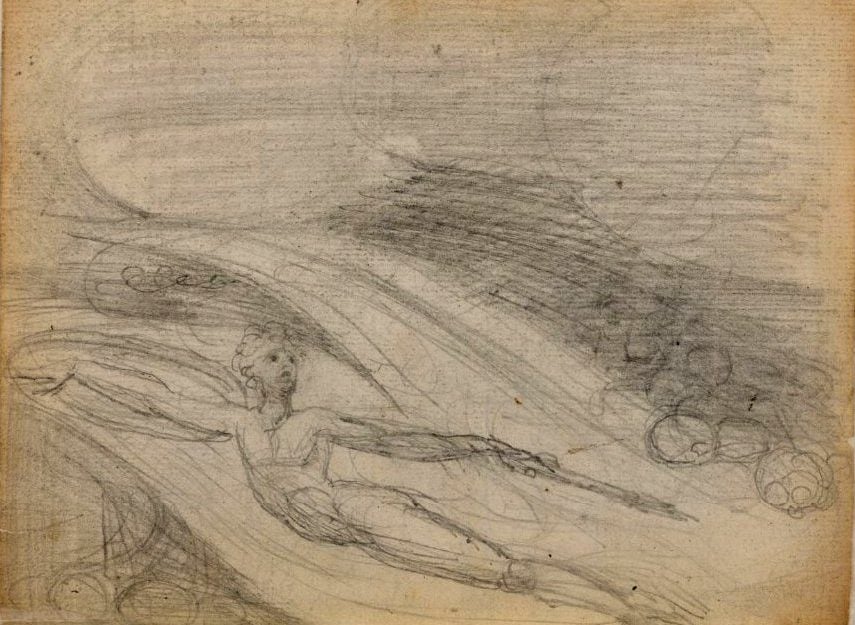The human body is a state subject to the visionary, the pulling transcendence of momentary experiences caught between the real and sublime.
William Blake perceived shadows in the mundane world, watching visions pass over the experiences he witnessed every day. His early notebook shows a preoccupation with human vulnerability to the weathering of higher forces – the wrath of God, the grief of love, the silenced mouth of a punished entity coursing through a violent sky.
Centuries after Blake was seized by the violence of human existence, using ink to bleed us away, Tracey Emin began creating monoprint depictions of the violence of human experience, the destructive capability of sexual desire in a world without Blake’s prophecies and the potential for renewal.
Blake and Emin illustrate the higher realm through which it is possible to enter experiences of love and grief; Blake’s recurring themes of motherhood, shadows and the imagination exist within Emin’s early work. Both artists were the enfant terrible of their period; Blake rebelled against the pursuit of “general beauty” championed by the Royal Academy, Emin continues to be criticised for her overtly confessional and violent installations. Blake’s impassioned beginnings as an artist allow comparison with the contemporary Emin; her early work presenting violent, more-than-human shadows.
Since childhood, William Blake was seized by visions. As he aged these visions took on artistic complexity, bringing into his bedroom the presence of ancient prophets and painters like Raphael.
This heightened sense of perception burns through the notes and sketches in his first notebook from February 1787 (housed in the British Library). In this, we witness the importance of artistic beginnings – there are early versions of his later etchings, and early editions of poems from the infamous ‘Songs of Innocence and Experience’. The figures blur at the edges and resonate with the screams of a human existence haunted by the divine. In leaf 53, Blake has sketched a gaping profile, eyes drawn down, ruled by an unknown suffering. An unfinished centre sketch depicts an older figure guiding the body of an open-armed child.
In the last sketch, pencil seems to bleed along the paper, pulling the wings of an ambiguous angel-like creature who outstretches his thin arm. Underneath lies a seemingly dead figure, eyes upturned in a paradoxical state of pleasure and death. The wings and the corpse’s dress fray at the edges, phantoms burning away into lines of faded grey; they are an orchestra of the sublime and the mortal, playing us out in a haunting and flame-like ecstasy.
The entrance of a higher force, an unclear figure wanting to steal the mortal from their rest, cascades through Emin’s early work. Hers is a life of modern shadows, cast not from divinity but from reality – relationships, violence and sexual desire. Her 1989 monoprint, ‘ALL THINGS TO TEAR US APART’, shows two human figures in bed, their faces intertwined, becoming indiscernible from one another. Surrounding them, three dark figures reach towards the lovers to tear the covers away. These figures belong to the realm of the celestial; surrounded by the blink of stars they summon the higher forces of destruction belonging to Blake, the visions of nightmares tearing human life away from the state of existence.
Blake’s early sketches show his obsession with initiation into Experience from Innocence; the constant potentiality for innocence to be stolen or transition into adulthood. Emin’s concern is the initiation into sex, loss, and violence from a state of stolen innocence. Her 1997 ‘Scorfega’ depicts an indiscernible child mounted by a skeletal, death-like figure, their ribs sketched like an erratic heart monitor.
Blake’s Folio N73 contains a small, central sketch which resonates dramatically with Emin’s work – an elongated woman, her eyes darkened with pencil, holding an infant in her arms. Light sketching in the background creates the effect of the wall weeping. Beneath is a quotation from Milton: ‘Yet can I not persuade me. Thou art dead.” The sketch imposes the silence of unfulfilled motherhood.
For Emin, motherhood goes alongside themes of abortion, alcohol and abuse – she contorts figures in agony and grief, showing blood coming from between legs alongside the slanted words ‘Poor love I think shes lost it’ (2000) and ‘There was no where left but hell’ (2010), the latter depicting a woman strapped to a bed as she bleeds. Blake’s haunting Milton illustration corresponds to Emin’s faceless monoprints, showing the experience of pregnancy, birth, and loss remains unbound by time.
Through their early works, we can witness the initiation of two artistic minds into the violence of existence. Blake and Emin depict the violence and darkness held within beginnings – exalting their greatest concerns, exorcising their nightmares divine or mundane.
Blake’s faint, pencil note, ‘A vision of fear A vision of hope’, encapsulates the states both he and Emin desire to ignite; for Blake, the ‘vision’ takes dominion, allowing him to thread the ordinary with the divine through the medium of human states. For Emin, fear and hope form a dichotomy which splits her work but finds unity in its immediate expression of our complex humanity.



